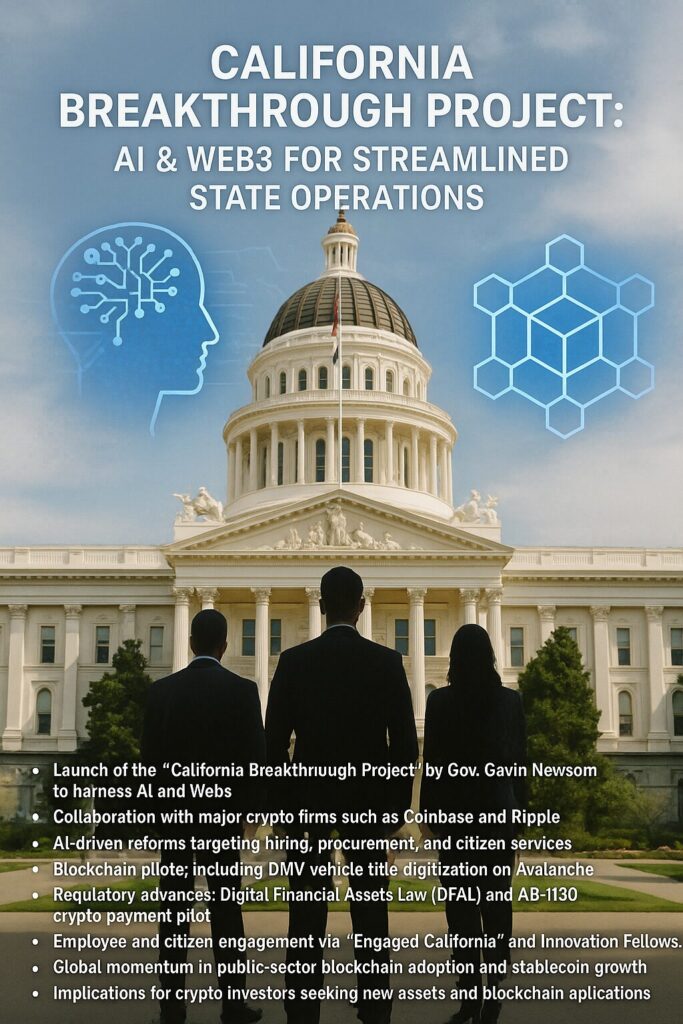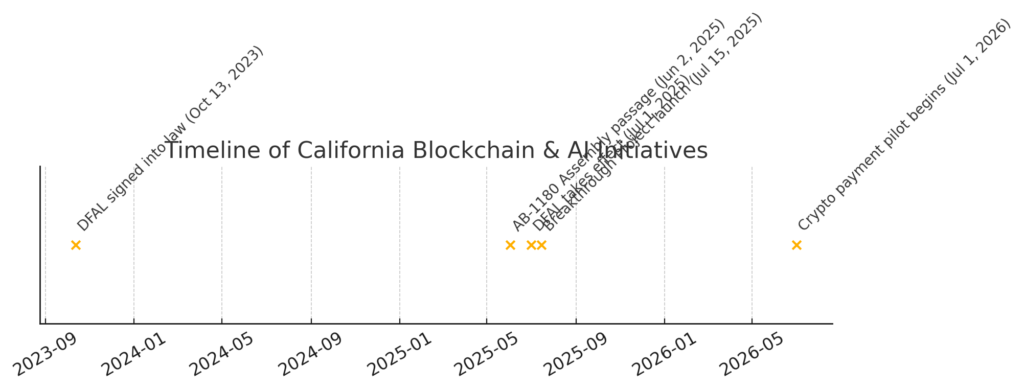
Main Points:
- Launch of the “California Breakthrough Project” by Gov. Gavin Newsom to harness AI and Web3
- Collaboration with major crypto firms such as Coinbase and Ripple
- AI-driven reforms targeting hiring, procurement, and citizen services
- Blockchain pilots, including DMV vehicle title digitization on Avalanche
- Regulatory advances: Digital Financial Assets Law (DFAL) and AB-1180 crypto payment pilot
- Employee and citizen engagement via “Engaged California” and Innovation Fellows
- Global momentum in public-sector blockchain adoption and stablecoin growth
- Implications for crypto investors seeking new assets and blockchain applications
1. Project Launch and Objectives
On July 15, 2025, Gov. Gavin Newsom announced the California Breakthrough Project, a statewide initiative to modernize government operations through advanced technologies such as artificial intelligence and Web3. This executive-led effort (via Administrative Order N-30-25) mandates all state agencies to identify and implement efficiency measures within 90 days, with a view toward reducing costs and improving service quality.
The project aims to:
- Audit existing processes—for example, hiring and procurement—across departments.
- Pilot AI and blockchain solutions in areas plagued by bureaucratic delays.
- Ensure transparency through public consultations with labor unions and citizen groups.
2. Public-Private Collaboration: Coinbase & Ripple Involvement
A key feature of the Breakthrough Project is its advisory council, which held its inaugural meeting on June 6, 2025, at Ripple’s San Francisco headquarters. Attendees included Ripple co-founder Chris Larsen and senior executives from Coinbase. This group will work directly with state staff to pinpoint pain points in frontline services, from bid solicitations to welfare disbursements.
Pilot proposals under consideration include:
- Smart contracts for automated benefit transfers.
- Blockchain-secured audit trails for procurement.
- AI-driven case management for social programs.
3. AI Integration Across State Agencies
Leveraging California’s robust AI ecosystem, Newsom’s order instructs agencies to adopt machine learning for tasks such as fraud detection and predictive resource allocation. Privacy safeguards will accompany all deployments, ensuring compliance with state data-protection standards.
Examples under review:
- AI resume-screening to expedite hiring.
- Geo-tagged imagery analysis for infrastructure inspection.
- Chatbot-driven citizen help desks for faster response times.
4. Blockchain Pilots: DMV Avalanche & Beyond
The California Department of Motor Vehicles (DMV) is set to digitize 42 million vehicle titles using Avalanche’s high-throughput blockchain. This pilot will explore on-chain record-keeping to reduce title fraud and streamline lien processing.
Other proposed use cases:
- Immutable public-record registries.
- Decentralized identity for welfare verification.
- Tokenized asset management for state-owned properties.
5. Regulatory Framework: DFAL and AB-1180
Digital Financial Assets Law (DFAL)
- Signed on October 13, 2023, by Gov. Newsom, the DFAL establishes a licensing regime for crypto firms.
- Effective July 1, 2025, it requires entities offering digital asset services to hold a DFPI license.
AB-1180 Crypto Payment Pilot
- Passed unanimously in the Assembly on June 2, 2025 (78–0) and now before the Senate.
- If enacted, it will enable state fees to be paid in Bitcoin and other approved digital assets, with a pilot running from July 1, 2026, through January 1, 2031.
Below is a timeline of these milestones and forthcoming events:

<!– The timeline chart is displayed above. –>
6. Employee & Citizen Engagement Initiatives
To ensure bottom-up input, the state will expand the “Engaged California” platform, enabling staff to submit efficiency ideas directly. Additionally, an Innovation Fellow program will recruit specialized technologists to embed within agencies, bridging the gap between policy and implementation.
7. Global Public Sector Blockchain Momentum
Worldwide, governments are piloting blockchain to enhance transparency and accountability. For instance:
- India’s Uttar Pradesh plans a blockchain-AI platform for welfare scheme distribution.
- Multilateral banks are exploring on-chain public spending audits, as highlighted in Citi’s “Digital Dollars” report, which forecasts stablecoin supply could reach $1.6 trillion by 2025.
These initiatives underscore blockchain’s potential to mitigate fraud, streamline services, and foster trust in public finance.
8. Stablecoin and Crypto Regulatory Trends in 2025
The U.S. Congress’s Crypto Week (July 14–18, 2025) will debate landmark bills—CLARITY Act, GENIUS Act, and Anti-CBDC Surveillance Act—aimed at defining regulatory guardrails for digital assets. Industry consensus suggests clearer rules will drive institutional adoption and bolster blockchain platforms such as Ethereum and Solana.
Meanwhile, stablecoins are gaining traction:
- Expected to remain 90% USD-pegged through 2030
- Potential to generate new demand for U.S. Treasuries
- Opportunities for tokenized financial products like real-estate and treasury bills.
9. Implications for Crypto Investors
For readers seeking new digital assets and revenue streams, California’s actions signal:
- Investment opportunities in on-chain infrastructure (e.g., Avalanche, Chainlink Oracles).
- Growing demand for compliance and licensing services under DFAL.
- Potential returns from stablecoins and tokenized Treasuries as government adoption scales.
Blockchain practitioners should monitor DFPI licensing trends and position solutions for public-sector use cases such as digital identity and procurement tracking.
Conclusion
California’s Breakthrough Project represents a paradigm shift in public-sector technology adoption. By combining AI, Web3, and legislative innovation, the state aims to set a global standard in government efficiency. For investors and developers, this opens diverse avenues—from compliance frameworks to digital-asset payment rails—ushering in a new era where blockchain and AI tangibly enhance civic life.

